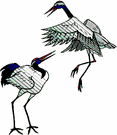Nesting American Dippers


American Dippers are nesting along the Arkansas River in what is called the "Bighorn Sheep Canyon"--that section from Parkdale (just west of Canon City about 15-20 miles) to near Salida. This is also the area where Christo has proposed his "Over the River" project which involves 2 years to install hardware (requiring the use of drilling rigs and other heavy equipment) then attaching about 2,400 cables across the river (some of which remain up for about 3 months before fabric is attached to it) so that fabric can be attached--and it's the fabric that's the art project. I am monitoring some of the bird life in the area as this is of concern.
I found one pair of dippers already had at least 1 fledgling (but thought I heard a second), the one in these photos. Another was feeding nestlings in a nest located under a bridge right in a section that is proposed for draping of fabric (and all the construction to get it up). I found additional dippers near bridges that may also be nesting.
I also found a Belted Kingfisher nesting in a dirt bank located about 50 feet from the Arkansas River in the Texas Creek area (this is a BLM area with a lot of heavy recreational use--much ATV and dirt bike use plus lots of fishermen in spring and rafters/kayakers in summer. It's amazing that these birds are able to nest and feed their nestlings as often as required given the disturbane.
SeEtta
















